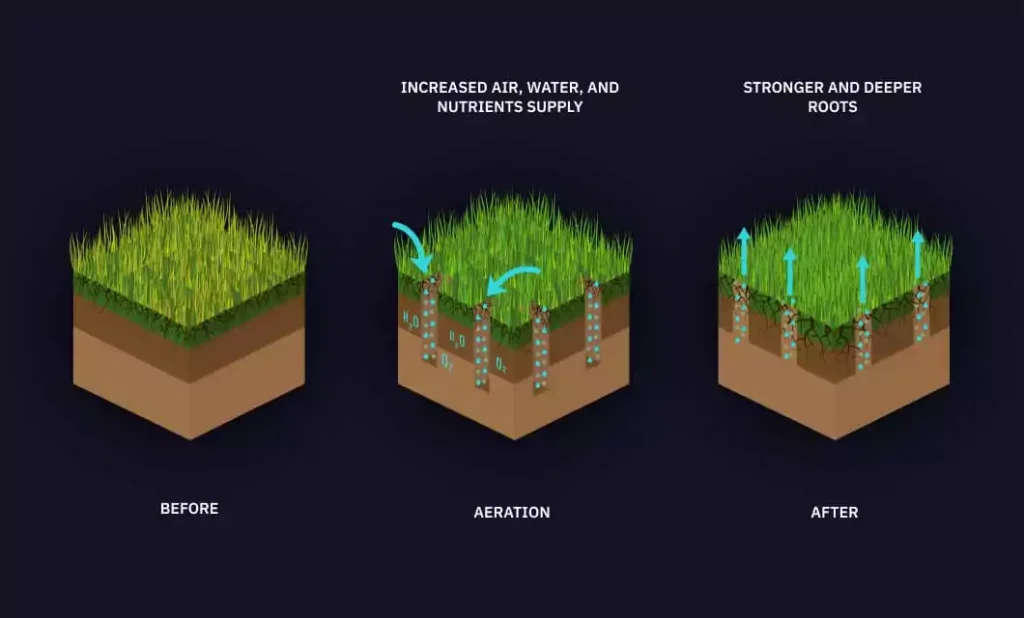Unlocking the secret to lush, thriving plants might be simpler than you think. If you’re passionate about gardening or farming, you know that healthy roots are the foundation of vibrant growth.
Yet, did you know that the way you treat your soil can make all the difference? Soil aeration is a game-changer that can transform your garden. It’s the key to ensuring your plants get the oxygen, nutrients, and water they desperately need.
Imagine your plants growing stronger, faster, and more resilient, thanks to a few simple techniques. This article will guide you through the best soil aeration techniques, showing you how to boost root growth and, ultimately, the vitality of your entire garden. Curious about how you can achieve this? Keep reading to discover the secrets your soil has been waiting for.

Importance Of Soil Aeration
Soil aeration is crucial for healthy root growth. It allows roots to breathe, absorb nutrients, and grow strong. Without proper aeration, soil becomes compacted, suffocating your plants and hindering their growth. Have you ever wondered why some plants thrive while others struggle? Often, the answer lies beneath the surface.
Why Air Matters To Roots
Roots need oxygen just like we do. Oxygen fuels root metabolism and supports nutrient uptake. When soil is compacted, air pockets disappear, reducing oxygen availability. This can stress plants, causing yellowing leaves and stunted growth. Imagine trying to breathe in a crowded room—your plants feel that too.
Signs Your Soil Needs Aeration
Look for signs of poor aeration. If water pools on the surface after rain, your soil might be compacted. Plants might also display slow growth or wilting. Check soil texture by squeezing a handful. If it forms a hard clump, it’s time to aerate. Don’t ignore these signs; they’re cries for help.
Simple Methods To Aerate Your Soil
Start with a garden fork. Push it into the soil and wiggle to create air channels. This method is effective for small gardens. Consider a core aerator for larger areas. It removes plugs of soil, boosting aeration. Try adding organic matter like compost. It breaks up compacted soil and enhances air flow. These methods are simple and can be done in a day.
Personal Experience With Soil Aeration
A few years ago, I struggled with my vegetable garden. Plants were wilting despite regular watering. I discovered soil compaction was the culprit. After aerating, my garden flourished. Tomatoes grew plump, and peppers turned vibrant red. It was a game-changer for my backyard oasis. Have you faced a similar challenge? Aeration might be your solution.
Consider how soil aeration can transform your garden. What steps will you take today to improve root health? Your plants depend on you for their lifeline. Isn’t it time to give them the air they need?

Traditional Aeration Methods
Traditional soil aeration methods have been utilized for centuries. These techniques are essential for promoting healthy root growth in plants. By improving air circulation and enhancing water absorption, traditional methods ensure that roots receive the nutrients they need. They are simple yet effective, making them accessible to gardeners of all experience levels.
Core Aeration
Core aeration involves removing small plugs of soil from the ground. This process helps reduce soil compaction. It allows roots to breathe better. Improved oxygen flow leads to healthier plant growth. Core aeration is often performed using a mechanical aerator. This tool efficiently extracts soil plugs, promoting better root development.
Slicing Aeration
Slicing aeration uses rotating blades to cut through the soil. This method creates narrow slits in the ground. These slits improve air and water movement. Unlike core aeration, slicing does not remove soil. It is less disruptive but still effective in reducing compaction. Slicing aeration is ideal for lawns and gardens with mild compaction.
Spiking
Spiking is a simple and manual method. It involves pushing spikes into the ground to create holes. These holes help in improving soil aeration. Spiking is best for small areas with light compaction. Gardeners often use spiked shoes or forks for this purpose. Although less effective than core aeration, spiking is convenient for quick fixes.
Manual Aeration Tools
Manual aeration tools include hand forks and hollow tines. These tools help break up compacted soil. They allow gardeners to target specific areas easily. Manual aeration is labor-intensive but cost-effective. It is suitable for small gardens or areas hard to reach with machines. Regular use of manual tools ensures better aeration over time.
Innovative Aeration Solutions
Different soil aeration techniques boost root growth by improving air and water flow. These methods enhance nutrient absorption and overall plant health. Innovative solutions ensure roots get adequate oxygen for optimal development.
When it comes to improving root growth, traditional methods of soil aeration sometimes fall short. That’s why innovative aeration solutions can play a pivotal role in nurturing healthier plants. These techniques not only facilitate better air and water flow but also create an optimal environment for roots to thrive. Let’s dive into some of the most forward-thinking approaches to soil aeration that you can easily try in your garden.1. Aeration Spikes And Shoes
Have you ever thought about aerating your garden while you walk? Aeration spikes and shoes allow you to do just that. These tools feature long spikes attached to the bottom, which penetrate the soil as you walk, creating small holes for better air and water absorption. This method is perfect for small gardens and lawns, providing a fun and efficient way to enhance root growth without heavy equipment.2. Liquid Soil Aerators
Liquid soil aerators are gaining popularity for their ease of use and effectiveness. These products break down compacted soil using natural enzymes and microorganisms. Simply spray the solution over your lawn or garden, and let the natural processes do the work. It’s an excellent option if you’re looking to improve your soil health without physical labor.3. Core Aerators
Core aerators are a classic tool with a modern twist. Unlike spike aerators, core aerators remove small plugs of soil from the ground, reducing compaction more effectively. Renting a core aerator for a day can make a huge difference in your garden’s health. You’ll notice enhanced root growth as the soil becomes more breathable and nutrient-rich.4. Vertical Mulching
Vertical mulching is a technique that involves drilling holes into the ground and filling them with organic material like compost or peat. This method provides a nutrient boost directly to the roots and improves water retention. If you’ve ever struggled with dry patches in your garden, vertical mulching could be the solution you’ve been looking for.5. Air Injection Technology
How about infusing your soil with air using cutting-edge technology? Air injection tools blast air deep into the soil, breaking up compaction layers and encouraging root expansion. While this method may be more costly, it is highly effective for large gardens or landscapes needing extensive aeration. Each of these innovative aeration solutions offers unique benefits. Have you tried any of these techniques, or do you have another favorite? Share your thoughts and experiences in the comments below. Your garden will thank you for giving its roots room to grow!
Impact On Crop Yields
Soil aeration is vital for root growth, directly affecting crop yields. Proper aeration enhances nutrient uptake and water absorption. This leads to healthier plants and better produce. Farmers notice significant improvements in yield with good aeration practices.
Compacted soil restricts root growth. This limits access to essential nutrients and water. Aerating the soil allows roots to expand and thrive. As a result, plants grow stronger and more productive. Let’s explore how different techniques impact crop yields.
Enhanced Nutrient Uptake
Aerated soil improves nutrient absorption by roots. Nutrients like nitrogen, phosphorus, and potassium reach the roots more efficiently. This ensures plants receive the nourishment they need. Healthy plants produce more, increasing crop yields.
Improved Water Absorption
Properly aerated soil absorbs water more effectively. Roots access water easily, reducing plant stress during dry spells. Consistent water supply boosts plant health. Consequently, plants yield more produce.
Reduced Soil Compaction
Soil compaction hinders root growth and nutrient flow. Aeration alleviates compaction, creating space for roots. This encourages deeper root systems. Stronger roots mean better plant anchorage and nutrient uptake. This translates to higher crop yields.
Increased Microbial Activity
Aerated soil boosts microbial life. Microbes break down organic matter, enriching the soil. Nutrient-rich soil supports robust plant growth. Active microbial life contributes to higher crop yields. Farmers see the difference in their harvests.
Conclusion
Healthy roots need well-aerated soil. This improves plant growth significantly. Try different aeration techniques. Find what works best for your garden. Remember, compacted soil harms roots. Loosen it up regularly. Use tools like a garden fork or aerator. Organic matter helps too.
Add compost or mulch to your soil. Keep an eye on drainage as well. Too much water can suffocate roots. Regular aeration ensures better oxygen flow. Your plants will thank you with lush growth. Happy gardening!


